(Oct. 2009 Version)
Abstract
Despite a two-thirds reduction in global nuclear arsenals since 1986, new scientific research makes it clear that the environmental consequences of nuclear war can still end human history. A series of peer-reviewed studies, performed at several U.S. universities, predict the detonation of even a tiny fraction of the global nuclear arsenal within large urban centers will cause catastrophic disruptions of the global climate and massive destruction of the protective stratospheric ozone layer. A nuclear war fought with several thousand weapons would leave the Earth uninhabitable.
The studies conclude that a “regional” nuclear conflict between India and Pakistan, in which 100 Hiroshima-size weapons were exploded in the cities of those nations, could produce as many fatalities as World War II1 and would significantly disrupt the global climate for at least a decade. Up to 5 million tons of smoke would quickly rise above cloud level and block about 10% of the light from reaching surface of the Northern Hemisphere; the smoke would remain in the stratosphere for ten years and impact average surface temperatures for more than a decade. Following such a “regional” nuclear conflict, average surface temperatures beneath the smoke layer would become colder than they have been in the last 1000 years, significantly shortening growing seasons and reducing average global precipitation.2
The combined explosive power of 100 Hiroshima-size weapons represents less than 1% of the explosive power contained within the currently deployed and operational US-Russian nuclear arsenals. As of 2009, virtually all of the land-based strategic nuclear forces of both the US and Russia remain on alert and ready to launch with only a few minutes warning.3 The new research predicts that immense firestorms, produced by a nuclear war fought with these weapons, could loft 150 million tons of smoke into the stratosphere. There it rapidly would block 70% of sunlight from reaching the surface of the Northern Hemisphere and 35% of sunlight from reaching the Southern Hemisphere.4
Under such conditions, it would only require a matter of days or weeks for daily minimum temperatures to fall below freezing in the largest agricultural areas of the Northern Hemisphere. Nightly killing freezes would continue to occur for a period of between one to three years. Average surface temperatures would become colder than those experienced 18,000 years ago at the height of the last Ice Age, and the prolonged cold would cause average rainfall to decrease by up to 90%. Growing seasons would be completely eliminated for more than a decade and cause most humans and large animal populations to die of starvation.5
Deadly Climate Change from Nuclear War
Nuclear detonations within urban and industrial areas would ignite immense mass fires which would burn everything imaginable and create millions of tons of thick, black smoke (soot). This soot would ultimately be lofted into the stratosphere. There it would absorb and block sunlight from reaching the lower atmosphere where greenhouse gases mainly reside, and thus act to reduce the natural greenhouse effect.6
The profound darkness and global cooling predicted to be result of this process (along with massive amounts of radioactive fallout and pyrotoxins7, and ozone depletion) was first described in 1983 as nuclear winter.8 Joint research by Western and Soviet scientists led to the realization that the climatic and environmental consequences of nuclear war, in combination with the indirect effects of the collapse of society, could produce a nuclear winter which would cause famine for billions of people far from the war zones.9
These predictions led to extensive international research and peer review during the mid-1980s. A large body of work which essentially supported the initial findings of the 1983 studies was done by such groups as the Scientific Committee on Problems of the Environment (SCOPE),10 the World Meteorological Organization,11 and the U.S. National Research Council of the U.S. National Academy of Sciences.12
The idea of nuclear winter, published and supported by prominent scientists, generated extensive public alarm and put political pressure on the U.S. and the U.S.S.R. to terminate a runaway nuclear arms race which, by 1986, had created a global nuclear arsenal of more than 65,000 nuclear weapons. Unfortunately, this was anathema to the nuclear weapons establishment and thus nuclear winter created a backlash among many powerful conservative groups, who undertook an extensive media campaign to brand it as “bad science” and the scientists who discovered it as “irresponsible.”
Critics used various uncertainties in the studies and the first climate models (which are relatively primitive by current standards) as a basis to denigrate and reject the concept of nuclear winter. In 1986, the Council on Foreign Relations published an article by scientists from the National Center for Atmospheric Research (NCAR), who predicted drops in global cooling about half as large as those first predicted by the 1983 studies and described this as a ‘nuclear autumn.’
Subsequent widespread criticism, in such publications as the Wall Street Journal and Time Magazine, often used the term “nuclear autumn” to imply that no important climatic change would result from nuclear war. In 1987, the National Review called nuclear winter a “fraud.” In 2000, Discover Magazine published an article which described nuclear winter as one of “The Twenty Greatest Scientific Blunders in History.”13
Sadly enough, for almost two decades this smear campaign limited serious discussion and prevented further studies of nuclear winter – and such criticism will continue.14 Yet the basic findings of the nuclear winter research, that extreme climatic changes would result from nuclear war, were never scientifically disproved and have been strengthened by the latest studies.
Most importantly, the new studies show that the original research actually underestimated by an order of magnitude the amount of time the soot from nuclear firestorms would remain above cloud level to block sunlight. This greatly magnifies the impact such a global smoke layer would have on weather and climate. The new studies clearly demonstrate that massive changes in climate created via nuclear conflict, which are much less severe than “nuclear winter”, would certainly have catastrophic and devastating impacts on human populations.
Regional Nuclear Conflict Fought with Low-Yield Nuclear Weapons
To create the new studies, U.S. researchers used the latest NASA Goddard Institute for Space Studies climate model (Model 1E, also used for the Intergovernmental Panel on Climate Change), which is able to model the entire troposphere, stratosphere, and mesosphere from the Earth’s surface up to 80 kilometers. They simulated a small nuclear war between two countries in the sub-tropics in which each nation attacked the other’s most densely populated urban centers with 50 Hiroshima-size (15 kiloton per weapon) low-yield nuclear bombs.15
This scenario is possible because the smallest nuclear weapon states today (India and Pakistan) are each believed to possess more than 50 of these low-yield weapons, and an arsenal of this size (or larger) could be acquired by other nations in the near future. Thirty-two countries that do not now have nuclear weapons own sufficient fissionable nuclear materials to construct weapons, some in a relatively short period of time.16
U.S. warplanners aim their extensive nuclear arsenal at a mix of military targets (nuclear forces, conventional forces, leadership and communication facilities, and war-supporting industries)17 and it is assumed that Russian warplanners do the same. However, it is commonly believed that small nuclear powers with limited arsenals are most likely to aim their weapons at the largest cities of their adversaries.
Toon et al. calculated that a “regional” nuclear war which employed this targeting strategy would create 1-5 million metric tons of soot from the burning cities.18 Robock et al. used the NASA climate model to demonstrate that this soot would be lofted to near the top of the stratosphere. 19 There the smoke would remain, far above the area where weather occurs, for a decade – about ten times longer than previously thought possible.
Further modeling demonstrated that smoke particles from much larger nuclear conflicts would also remain in the upper stratosphere for at least a decade,20 and these findings provided the basis for rejecting the conclusion of the studies which suggested that “nuclear autumn” instead of nuclear winter would follow a full-scale war. Robock’s team also discovered that smoke in the sub-tropical latitudes would undergo more solar heating than smoke studied in previous nuclear winter scenarios, and this heating would insure that the smoke particles would be lofted into the stratosphere year-round, regardless of the month in which the war would occur.21
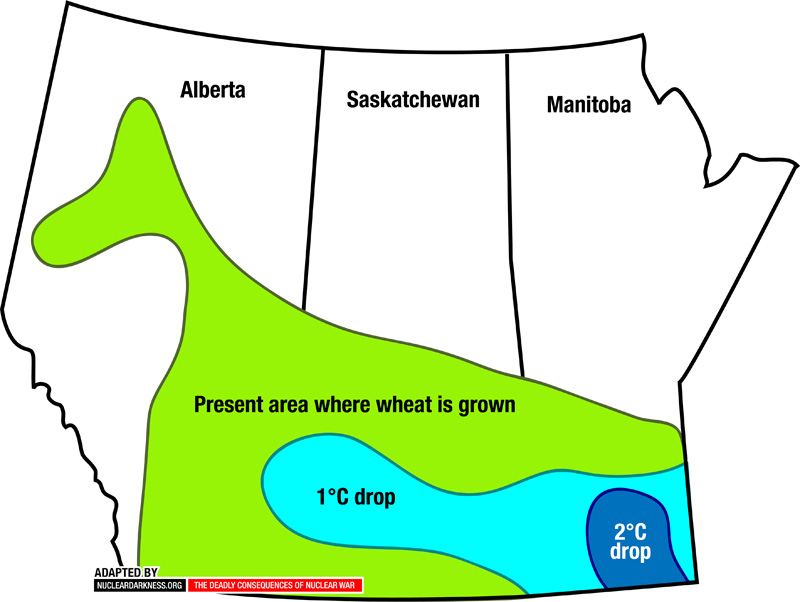
Figure 1: Map showing the present principal area of Canadian wheat production and the reduction that would result from small decreases in average surface temperature21
Although there would not be enough sunlight blocked to create a “nuclear winter”, the massive smoke emissions from the fires of a small “regional” nuclear war would cause a global climate change unprecedented in human history. In a matter of days, average temperatures in the Northern Hemisphere would become colder than any experienced during the last 1000 years.23 Growing seasons in the middle latitudes would immediately be significantly shortened, completely eliminating some crops that had insufficient time to reach maturity.
The studies predict climatic consequences significantly greater and more persistent than those which resulted from greatest volcanic eruption of the past 500 years, the 1815 Tambora eruption in Indonesia. Tambora lofted enormous amounts of volcanic smoke particles into the stratosphere, which blocked and scattered enough sunlight to cause the 1816 “Year Without Summer,” when killing frosts disrupted agriculture every month of the summer in New England and widespread harvest failure and famine occurred in Europe.
The long-term global climate, as measured by the average surface temperature over the planet, has not varied by more than 10º C from current values during the entire climatic history of the Earth accessible to modern science.24 Ice Ages represent periods of cooling of about 5º C below the global average which extend for periods of thousands of years. Modern agriculture is finely tuned to the present climate and would be severely impacted by rapid average temperature declines of even a few degrees Celsius.
Computer simulations of the regional nuclear conflict predict a global average surface cooling of 1.25º C which would persist for three years, with the global average temperature still 0.5º C below normal a decade after the war. One year after the smoke injection there would be temperature drops of several degrees Celsius within the grain-growing interior regions of Eurasia and North America. There would be a corresponding shortening of growing seasons by up to 30 days and a 10% reduction in average global precipitation – which would have major impacts on global food supplies.25
In addition, the stratospheric smoke plumes from this regional conflict would significantly disrupt the ozone layer. Studies by Mills, et al, predict ozone losses of 25–45% at mid latitudes, and 50–70% at northern high latitudes persisting for 5 years, with substantial losses continuing for 5 additional years.26 Such levels of ozone loss have previously been forecast only for large nuclear conflicts between the U.S. and the former U.S.S.R.27
Severe ozone depletion would allow intense levels of ultraviolet light to reach the Earth even with the stratospheric smoke layer in place. It is unknown what effects such massive increases in UV would have upon terrestrial and marine wildlife and ecosystems.
Unfortunately, no studies using modern climate models have yet been done to assess ozone depletion following larger nuclear conflicts fought with high-yield strategic nuclear weapons. This is an area of critically important research which should receive funding.
Nuclear War Fought with High-Yield Strategic Nuclear Weapons
Using the vastly more modern NASA climate model and new supercomputers, in 2007 Robock et al. re-examined the climate response to a range of nuclear wars which detonated moderate and large portions of the global nuclear arsenal in a combination of urban, industrial, and military targets.28 The researchers utilized data from previous studies to calculate that the “moderate” and “large” nuclear conflicts would produce 50 and 150 million tons of smoke,29 which they found would be lofted into the stratosphere, where it would impact surface climate for more than a decade.30
The “moderate” war simulation employed one third of the global nuclear arsenal (1,667 megatons) – roughly equivalent to 60% of the explosive power contained in the strategic nuclear weapons now kept at high-alert, launch-on-warning status by the U.S. and Russia.31 The large war simulation used one of the current published estimates for the total explosive power of the entire global nuclear arsenal (approximately 5,000 megatons). However, additional research in 2008 indicated that significantly lower total numbers of weapons and megatonnage (explosive power) could cause the same levels of damage and climate change previously predicted in the large war scenario.32
A large nuclear war would produce enough smoke and soot to quickly block a very large percentage of sunlight from reaching the surface of the entire Northern and Southern Hemispheres. In the target areas, for the first few days after the attack, sunlight would be reduced so much that at mid-day it would appear as dark as a moonlit night before the war.33
Within a matter of days, winds in the upper atmosphere would distribute this smoke and soot around the Earth. The research predicts that 150 million tons of stratospheric soot would block 70% of sunlight from reaching the surface of the Northern Hemisphere and 35% of sunlight from reaching the lands of the Southern Hemisphere.34 This smoke layer would remain the stratosphere for ten years and its cooling effects would last for many years after it had dissipated.
This profound darkening of the sky would cause average global surface air temperatures to rapidly cool by 7-8º C. Even a decade after the fires had gone out, the Earth’s average surface temperatures would be cooled by 4º C. Both the moderate and large nuclear wars would produce cooling equal to or greater than that experienced 18,000 years ago during the coldest period of the last Ice Age35 – and these temperature drops would occur abruptly in a matter of days or weeks, rather than over centuries or millennia.
The most recent research (December, 2008) predicts that a U.S.-Russian war which detonated 4400 strategic nuclear weapons would put up to 180 million tons of soot into the stratosphere.36 The resulting nuclear darkness would cause rapid cooling of more than 20º C over large areas of North America and of more than 30º C over much of Eurasia, including all agricultural regions (Figure 2). Daily minimum temperatures in the world’s agricultural heartlands would plummet below freezing for one to three years.
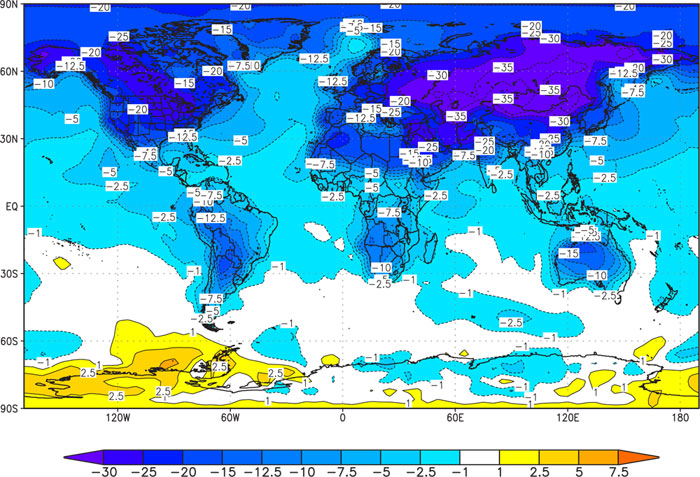
Figure 2: Surface Air Temperature (degree C) changes following a full-scale nuclear war averaged for June, July, and August of the year following the conflict33
Under such conditions, it would be impossible to grow food crops for more than a decade. Long-term consequences of the large nuclear conflict are implied by Figure 3, which depicts predicted decreases in the growing seasons during the third year following the conflict.
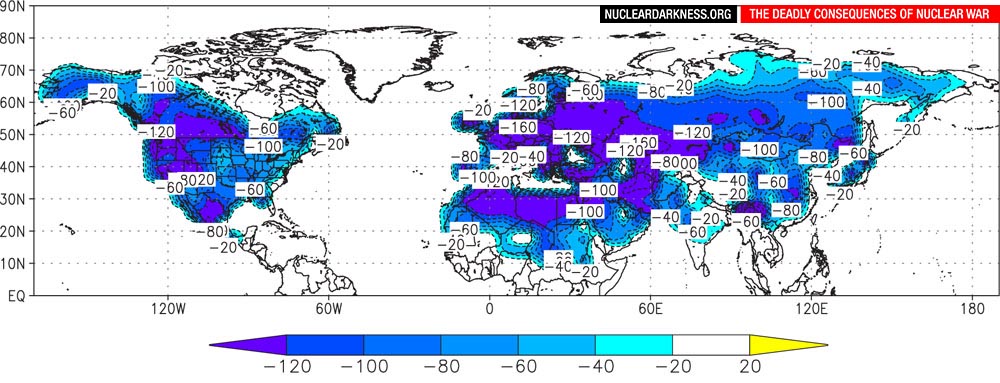
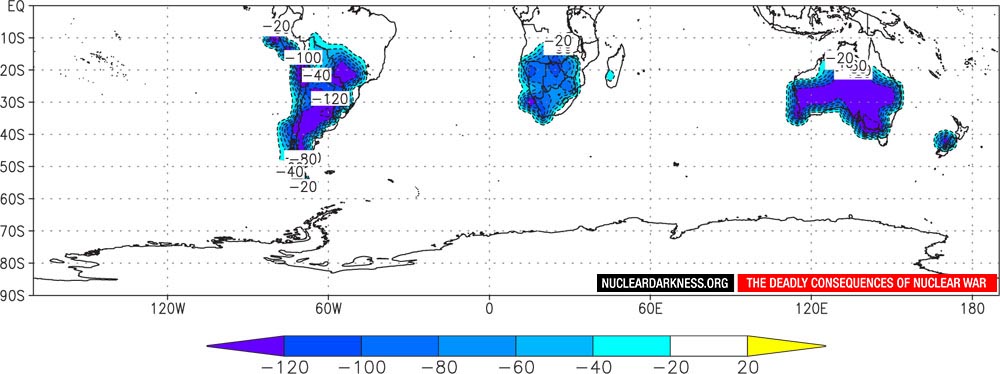
Figure 3 : Changes in the growing season (the time period with freeze-free days) in the third year following a large nuclear war which caused 150 million tons of smoke to enter the stratosphere34.
Agriculture would be affected by not only the catastrophic drops in temperature, but also by a dramatic decrease in sunlight (insolation) and precipitation. The cooling of the Earth’s surface would weaken the global hydrological cycle and the Northern Hemisphere summer monsoon circulations would collapse because the temperature differences that drive them would not develop. Consequently, a 45% reduction in average global precipitation is also predicted to occur. Catastrophic climatic effects lasting for many years would occur in regions far removed from the target areas or the countries involved in the conflict.39
Nuclear War Fought with U.S. and Russian High-Alert Strategic Nuclear Arsenals
The failure of the U.S. and Russia to relax their Cold War nuclear confrontation has led each nation to continue to operate under policies that assume the opposing side could authorize a disabling nuclear attack against them. Both nations consequently still maintain a large fraction of their strategic nuclear arsenals on high-alert status (in 2009, more than 2000 warheads were on high-alert),40 with virtually all their land-based intercontinental ballistic missiles able to be launched within 30 seconds to 3 minutes, apparently operating under the policy of launch-on-warning.41 Thus the “moderate” war simulated in the new research, which as noted contains a destructive power equivalent to that contained by these high-alert arsenals, can be ordered and executed by either of these nations in less time than it takes to read this article.
The 2007 studies predicted that a “moderate” nuclear war which lofted 50 million tons of soot into the stratosphere would cause average global surface air temperatures to plummet 3.5-4º C, roughly half the drop predicted for a war which created 150 million tons of stratospheric soot.42 Consider that average global temperature declines of 3-4º C would prevent all grain production in Canada, and a single night below freezing is sufficient to destroy the entire Asian rice crop.43 Because of its rapid onset, this level of climate change (although the duration would be much briefer) would cause more stress to plant and animal life than would a severe Ice Age.44
Climatic Consequences of Nuclear Conflict Compared with Global Warming
Climatic changes resulting from nuclear conflict would occur many thousands of times faster – and thus would likely be far more catastrophic – than the climatic changes predicted as a result of global warming.45 The rapidity of the war-induced changes, appearing in a matter of days and weeks, would allow human populations and the whole plant and animal kingdoms no time to adapt.
It is worth noting that the same methods and climate models used to predict global warming were used in these studies to predict global cooling resulting from nuclear war. These climate models have proved highly successful in describing the cooling effects of volcanic clouds during extensive U.S. evaluations and in international intercomparisons performed as part of the Fourth Assessment of the Intergovernmental Panel on Climate Change.46
Predicted drops in average global temperatures caused by a range of nuclear conflicts are contrasted with the effects of global warming during the last 1,000 years in Figure 4.
Global Warming versus Global Cooling from Nuclear War
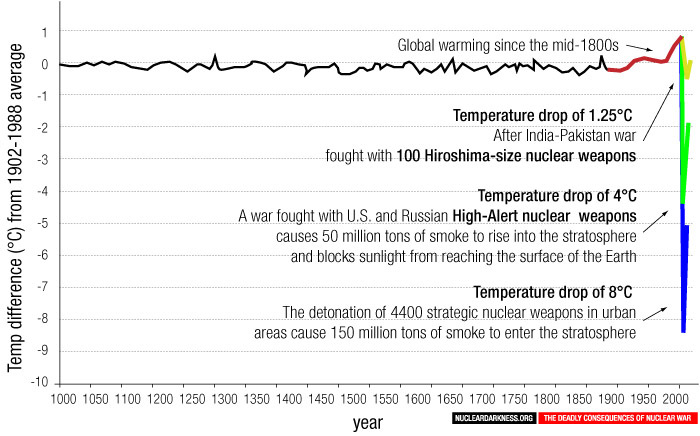
Figure 4: Northern Hemisphere average surface air temperatures anomalies during the last 1000 years contrasted with forecast temperature drops from a range of nuclear conflicts. The anomalies are with respect to the 1902-1988 Northern Hemisphere average surface air temperatures. 42
There are, of course, other important considerations which must be made when estimating the overall environmental and ecological impacts of nuclear war. These must include the release of enormous amounts of radioactive fallout, pyrotoxins, and toxic industrial chemicals into the ecosystems. A decade after the conflict, when the smoke begins to clear, there will also be massive increases in the amount of deadly ultraviolet light which will reach the surface of the Earth as a result of ozone depletion. All these by-products of nuclear war must be taken into account when comparing the danger of nuclear conflict to other potential dangers now confronting humanity and life on Earth.
Conclusions
The scientific studies summarized in this paper make it clear that the environmental consequences of nuclear war threaten the continued survival of the human species. Yet neither the U.S., nor Russia, nor any other nuclear weapons state has ever officially evaluated what effects a war fought with their weapons would have upon the Earth’s climate and ecosystems.
Therefore, we cannot allow our political and military leaders to continue to ignore the grave threats which their nuclear arsenals pose to the global environment and human existence. The nuclear weapon states should be required to create Environmental Impact Statements on the likely results of the detonation of their arsenals in conflict.
The environmental consequences of nuclear war must be included as primary considerations in the ongoing debate about the abolition of nuclear arsenals. Without this essential information, the debate loses the sense of necessary urgency needed to bring about fundamental change in the nuclear status quo.
The U.S. and Russia must recognize the senselessness of continued planning for a nuclear first-strike which, if launched, would make the whole world – including their own country – uninhabitable. As a first step, they should end their preparations for the pre-emptive use of their nuclear arsenals, stand-down their high-alert strategic nuclear forces, and eliminate the standard operating procedure of launch-on-warning.48
Nuclear arms control agreements can no longer focus primarily on the dismantlement of delivery systems and fail to include the verified dismantlement of nuclear warheads. Future negotiations must consider all the potential effects of the total number of nuclear weapons in the nuclear arsenals.49
It is essential that all the nuclear weapon states be convinced of the need to honor their commitments under Article VI of the Non-Proliferation Treaty, to act “in good faith” to eliminate their nuclear arsenals. As long as they ignore this commitment and maintain nuclear weaponry as the cornerstone of their military forces, they confer validity to the false idea that nuclear weapons provide security to those who possess them, and thus encourage non-nuclear weapon states to follow in their footsteps.
The unalterable conclusion is that a nuclear war cannot be won and must not be fought. Nuclear weapons must be seen not only as instruments of mass murder, but as instruments of global annihilation which put all humanity and civilization under a common threat of destruction.
- References
- Owen B. Toon, Richard P. Turco, Alan Robock, Charles Bardeen, Luke Oman, and Georgiy L. Stenchikov, Atmospheric effects and societal consequences of regional scale nuclear conflicts and acts of individual nuclear terrorism, Atmospheric Chemistry and Physics, Vol. 7, 2007, p. 1973-2002.
- Alan Robock, Luke Oman, Georgiy L. Stenchikov, Owen B. Toon, Charles Bardeen, and Richard P. Turco, Climatic consequences of regional nuclear conflicts, Atmospheric Chemistry and Physics, Vol. 7, 2007, p. 2003-2012.
- Starr, Steven, High-Alert Nuclear Weapons: the Forgotten Danger, SGR Newsletter, Autumn, 2008, pp. 1 – 16.
- Alan Robock, Luke Oman, and Georgiy L. Stenchikov, Nuclear winter revisited with a modern climate model and current nuclear arsenals: Still catastrophic consequences, Journal of Geophysical Research – Atmospheres, Vol. 112, No. D13, 2007.
- Toon O, Robock A, Turco R, The Environmental Consequences of Nuclear War, Physics Today, vol. 61, No. 12, 2008, pp. 37-42.
- Water vapor, carbon dioxide, methane, and nitric oxide are the main greenhouse gases in the atmosphere. They allow short wavelength solar radiation to reach the Earth but absorb radiation of longer wavelength, which causes warming of the atmosphere. This process occurs naturally and has kept the Earth’s temperature about 33 Celsius degrees (59 Fahrenheit degrees) warmer than it would otherwise be. Current life on Earth could not be sustained without the natural greenhouse effect.
- A term to designate toxic chemicals released during combustion, particularly from plastics and industrial chemicals. In a nuclear war, sources of such materials would be widespread; mass fires in urban and industrial areas would release enormous amounts of pyrotoxins into the air, land, and water.
- R. P. Turco, O. B. Toon, T. P. Ackermann, J. B. Pollack, and Carl Sagan, Nuclear Winter: Global consequences of multiple nuclear explosions, Science, Vol. 222, No. 4630, December 1983, pp. 1283-1292.
- Robock et al., Climatic consequences…, op.cit., p. 2003.
- Scientific Committee on Problems of the Environment (SCOPE), Report 28, Environmental Consequences of Nuclear War: Vol. I, Physical and Atmospheric Effects by A. Ptticok, T.P. Ackerman, P.J. Crutzen, M.C. MacCracken, C.S. Shapiro & R.P. Turco (eds.), 1986, 2nd ed. 1989, Wiley & Sons, New York; Vol. II, Ecological and Agricultural Effects by M.A. Harwell and T.C. Hutchinson (eds.), 1985, 2nd ed. 1989, Wiley & Sons, New York; PDF files available at www.icsu-scope.org.
- G.S. Golitsyn and N.A. Phillips, Possible Climatic Consequences of a Major Nuclear War, World Meterological Organization, World Climate Program Report WCP-142, Geneva, 1986.
- U.S. National Research Council, The Effects on the Atmosphere of a Major Nuclear Exchange, National Academy Press, Washington, D.C., 1985; http://books.nap.edu/openbook.php?record_id=540&page=R1.
- Judith Newman, 20 of the Greatest Bunders in Science in the Last 20 Years, Discover Magazine, Vol. 27, No. 10, October 1, 2000; http://discovermagazine.com/2000/oct/featblunders.
- Russell Seitz (ed.), The ‘Nuclear Winter’ Meltdown. Photoshopping the Apocalypse, Adamant: What’s the matter with science and the media?, December 20, 2006; http://adamant.typepad.com/seitz/2006/12/preherein_honor.html.
- Robock, et al., Climatic consequences…, op.cit., p. 2003.
- Toon et al., p. 1974.
- Bret Lortie, A Do-It-Yourself SIOP, The Bulletin of the Atomic Scientists, July/August 2001, Vol. 57, No. 4, pp. 22-29.
- Toon et al., p. 1998.
- Robock et al., Climatic consequences…, op.cit., p. 2006.
- Robock et al., Nuclear winter revisited…, pp. 1-7 of 14.
- Ibid, p. 2004.
- Figure 4.8a on p. 302 of SCOPE Report 28, Vol. II, op.cit.
- Toon O, Robock A, Turco R, The Environmental Consequences of Nuclear War, op. cit. p. 39.
- Carl Sagan and Richard Turco, A Path Where No Man Thought – Nuclear Winter and the End of the Arms Race, Random House, New York, 1990, p. 22.
- Robock et al., Climatic consequences…, op.cit., p. 2005.
- Mills M, Toon O, Turco R, Kinnison D, Garcia R (2008). Massive global ozone loss predicted following regional nuclear conflict. Proceedings of the National Academy of Sciences (USA), Apr 8, vol. 105(14), pp. 5307-12.
- John W. Birks, and Sherry L. Stevens, Possible Toxic Environments Following a Nuclear War in: Fred Solomon and Robert Q. Marston (eds.), The Medical Implications of Nuclear War, National Academy of Sciences, 1986, pp. 160-161.
- There are approximately 23,300 nuclear weapons in the global nuclear arsenal; 95% of these weapons belong to the U.S. and Russia. About 8,400 of these weapons are fully operational weapons ready for immediate use. An additional 14,900 intact nuclear weapons are in a ‘reserve’ status, with some of these scheduled for dismantlement. About 5,850 of the operational weapons are high-yield strategic nuclear weapons with an explosive power equal to or greater than 100,000 tons of high explosive; there are at least several thousand strategic weapons also in reserve status.
- Robock et al., Nuclear winter revisited…, op.cit., state that this is the greatest area of uncertainty in their calculations, but note that the amount of smoke affects the amplitude but not the timescale of the climatic response, p. 12 of 14.
- Ibid., p. 3 of 14.
- As of 2009, a minimum of 2200 U.S. and Russian strategic nuclear warheads remain on high-alert status. These include a very high percentage of the warheads on U.S. and Russian land-based intercontinental ballistic missiles and some fraction of the warheads on U.S. and Russian nuclear submarines. The total yield of these U.S. and Russian high-alert strategic nuclear forces is the range of 960 to 1020 MT, which is roughly equivalent to 60% of the explosive power of the 1,667 MT model used in the simulations.
- Toon O, Robock A, Turco R, The Environmental Consequences of Nuclear War, Physics Today, vol. 61, No. 12, 2008, pp. 37-42.
- Personal correspondence with Alan Robock, Sept. 9, 2007.
- Personal correspondence with Luke Oman, Dec. 1, 2008.
- Robock et al., Nuclear winter revisited…, op.cit., p. 6 of 14.
- Toon O, Robock A, Turco R, The Environmental Consequences of Nuclear War, op. cit. p. 38.
- Robock et al., Nuclear winter revisited…, op.cit., Figure 4.
- Ibid, Figure 10.
- Ibid, p. 6 of 14.
- Starr, Steven, High-Alert Nuclear Weapons: the Forgotten Danger, op. cit., p. 1.
- Launch-on-warning (LOW) is the Cold War policy of launching a retaliatory nuclear strike while the opponent’s missiles or warheads are believed to be in flight, but before any detonation from the perceived attack has occurred. Early Warning Systems (EWS), high-alert nuclear-armed ballistic missiles, and nuclear command and control systems, all working together, provide the U.S. and Russia the capability to launch a nuclear retaliatory strike to a perceived nuclear attack before the attack arrives and is confirmed by nuclear detonations. However, it is the policy of Launch on Warning, converted into standard operating procedure, which could lead to the decision to launch solely on the basis of electronic EWS data. The combination of capability with policy has created what is commonly referred to as launch-on-warning status.
- Robock, et al., Nuclear winter revisited…, op.cit., p. 7 of 14.
- Sagan and Turco, op.cit., p. 101.
- Sagan and Turco, op.cit., p. 26.
- This comparison is not meant to minimize the dangers of global warming, which warrant grave concern, rather it is intended to make the point that the potential environmental dangers posed by nuclear war should receive at least as much attention as is that now being afforded to the issue of global warming.
- Robock et al., Nuclear winter revisited…, op.cit., p. 11 of 14.
- Ibid, Figure 9, adapted with permission.
- Alan Phillips, Steven Starr, Change Launch on Warning Policy, Moscow Institute of Physics and Technology Center for Arms Control, Energy and Environmental Studies, 2006; www.armscontrol.ru/pubs/en/change-low.pdf.
- Alan Robock, Owen B. Toon, Richard P. Turco, Luke Oman, Georgiy L. Stenchikov, and Charles Bardeen, The continuing environmental threat of nuclear weapons: Integrated policy responses needed, EOS Transactions American Geophysical Union, Vol. 88, No. 21, 2007, pp. 228.
